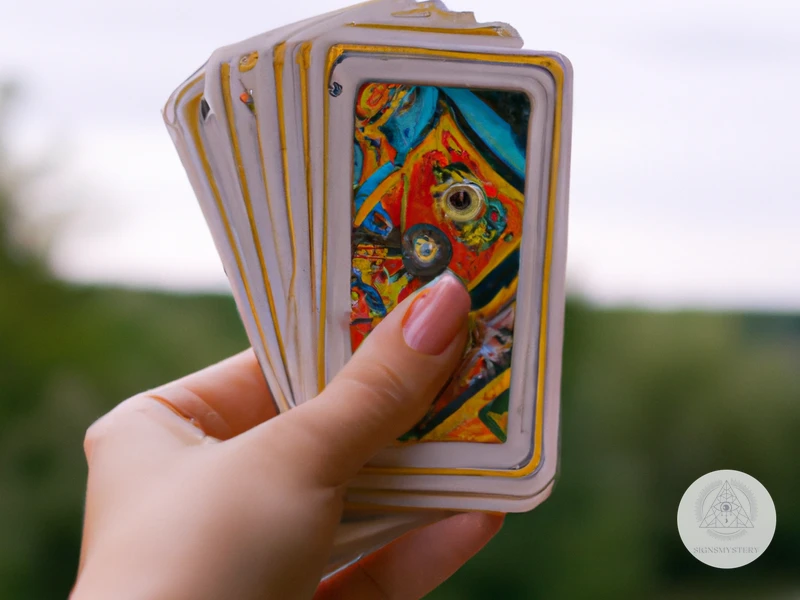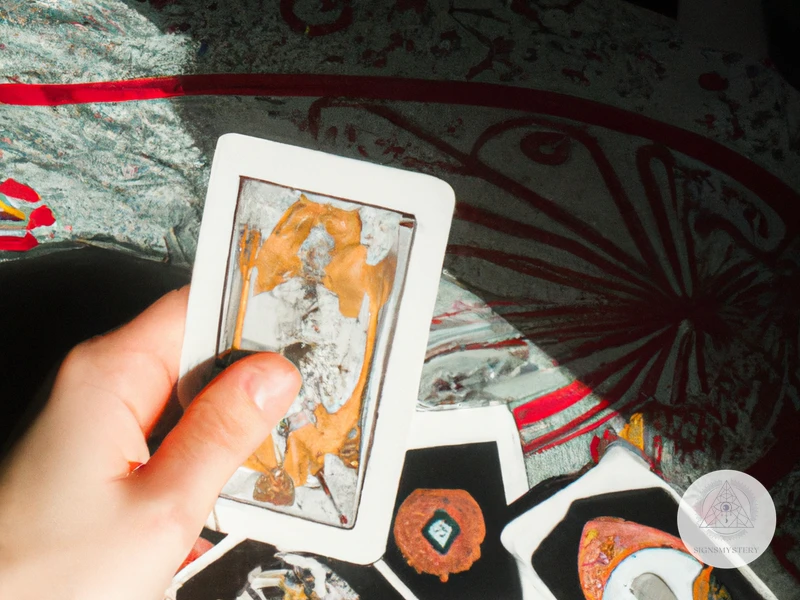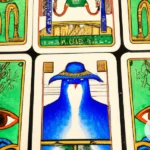The world can be a chaotic and overwhelming place, and at times it can feel like we have little control over our lives. This is where the concept of boundaries comes into play. Setting and maintaining healthy boundaries is crucial for self-care and protecting our emotional, physical, and mental wellbeing. Tarot, with its ability to tap into our subconscious and bring hidden truths to the surface, can be a powerful tool for exploring boundaries and developing self-protection strategies. In this article, we will delve into the topic of boundaries, learn how to use tarot to explore them, and discuss different techniques for self-protection. Are you ready to deepen your understanding and take control of your personal boundaries? Let’s embark on this journey together.
Understanding Boundaries

As we delve into the world of tarot, it’s important to first understand the significance of boundaries. Setting clear boundaries is an essential part of self-care and maintaining healthy relationships. It can be challenging to identify and communicate our boundaries, but the practice can lead to increased self-awareness and empowerment. In this section, we will explore the definition of boundaries, their importance, and different types of boundaries that can exist within our lives. By examining the concept of boundaries, we can then begin to use tarot as a tool for self-exploration and boundary-setting.
What are Boundaries?
Boundaries refer to the limits and guidelines we set for ourselves in various aspects of our lives, including personal, emotional, physical, and social. They help us establish a sense of safety and respect for ourselves and others, while ensuring that we are not being taken advantage of or mistreated.
Boundaries can be thought of as an invisible shield or protective barrier that we put up between ourselves and others. It’s important to recognize and respect our own boundaries, as well as the boundaries of others, to maintain healthy relationships and avoid harmful situations.
In terms of personal boundaries, these may be related to individual needs and preferences, such as how much personal space we require, what topics of conversation are off-limits, our values and beliefs, and the types of activities we enjoy participating in.
Emotional boundaries involve our ability to manage and express our emotions in a healthy manner, as well as our capacity to empathize with others without taking on their emotional baggage.
Physical boundaries refer to the physical space we occupy and our level of comfort with physical touch or proximity to others.
Social boundaries cover the way we interact with others, such as the amount of time we spend with different people, our comfort level with certain social situations, and our willingness to say no to requests or favors that don’t align with our priorities or values.
To learn more about mindfulness, meditation, and tarot, check out our article on Tarot Mindfulness Meditation. Additionally, if you’re interested in exploring Tarot spreads for self-care, head over to our article on Tarot Spreads for Self-Care.
Why are Boundaries Important?
Boundaries play a crucial role in maintaining healthy relationships and personal well-being, and it is essential to understand why they are important. By having defined boundaries, individuals can communicate their needs and expectations to others clearly, which, in turn, avoids conflicts and misunderstandings. Boundaries also help people maintain their sense of self by establishing limits and ensuring that they are respected. Failure to have and uphold boundaries can lead to emotional exhaustion, resentment, and burnout, which can greatly impact one’s mental and physical health.
Boundaries are essential for protecting oneself from harm and toxicity in relationships. They help individuals recognize when someone is overstepping their limits and infringing on their personal space. Sometimes people may not even realize they are crossing boundaries. In such instances, it is up to individuals to assert themselves and make their boundaries known firmly. By doing so, they protect themselves from negative influences, protect their self-worth, and maintain their personal power.
It’s important to note that boundaries aren’t always visible, and it’s up to individuals to identify and establish them. They differ from person to person and may depend on factors such as cultural background, personal values, and beliefs. What may be acceptable to one person might be completely unacceptable to another.
Boundaries are key to maintaining healthy relationships and personal growth. By understanding why they are important, individuals can create clearer boundaries, better protect themselves from toxic situations, and maintain their self-worth. Incorporating tarot into boundary-setting practices can help individuals explore their boundaries and protect their energy. On that note, let’s move onto exploring the use of tarot for boundary exploration and self-protection.
Types of Boundaries
Understanding different types of boundaries is crucial when exploring them with tarot. Here are the three main types of boundaries:
| Types of Boundaries | Description |
|---|---|
| Physical Boundaries | These boundaries refer to the space that you need between yourself and others. It’s important to establish physical boundaries to protect your personal space and feel safe and secure. Physical boundaries can also encompass your possessions and personal belongings. |
| Emotional Boundaries | Unlike physical boundaries, emotional boundaries define the line between your emotions and others. Having healthy emotional boundaries means you are able to identify and express your feelings appropriately without feeling responsible for the emotions of others around you. |
| Mental Boundaries | Mental boundaries involve your cognitive space – your thoughts, beliefs and personal values. Healthy mental boundaries can help you differentiate between your own thoughts and beliefs versus those imposed upon you by others. It helps to prevent being manipulated by others and allows you to make your own decisions. |
By understanding these different types of boundaries, you can begin exploring which ones may need strengthening or reinforcing. Tarot can be a powerful tool to help identify these boundaries, and help you establish healthy ones.
Using Tarot to Explore Boundaries
Exploring our boundaries can be a challenging and complex journey of self-discovery. It can be difficult to even know where to begin or how to approach this process. One way to gain insight and clarity on our boundaries is by using the powerful tool of Tarot. Tarot cards can help us explore our unconscious thoughts and emotions, providing us with valuable insights into our deepest desires and fears. With the right deck, spreads, and interpretation techniques, Tarot can be an effective means of identifying, understanding, and protecting our boundaries. Let’s delve deeper into how we can use Tarot to explore our boundaries and enhance our self-care routine.
Choosing the Right Deck
Choosing the right deck of tarot cards is an important step in exploring boundaries and self-protection with tarot. There are many different decks available, each with its own unique energy and symbolism. It’s important to choose a deck that resonates with you and feels right for the work you want to do.
Here are some tips for choosing the right deck:
- Choose a deck that speaks to you: Look for a deck that resonates with you on a personal level. You might be drawn to a particular theme, such as animals, nature, or mythology. You might also be drawn to a particular artist’s style or color palette. Trust your intuition and choose a deck that feels right.
- Consider the symbolism: Each deck has its own unique symbolism that can be used to explore boundaries and self-protection. Look for a deck that has imagery that resonates with your personal experiences and beliefs.
- Check the energy: Some decks have a lighter or darker energy than others. Consider the energy you want to work with and choose a deck that reflects that. For example, if you’re looking to explore difficult emotions and experiences, a deck with darker imagery might be more appropriate.
- Explore different options: Don’t be afraid to look at different decks before making your decision. You can browse online, visit a local metaphysical shop, or attend a tarot class or event to see different decks in person.
Remember, the right deck is the one that feels right for you and your personal journey. Don’t be afraid to experiment with different decks and see what works best for you.
If you’re interested in incorporating tarot into your self-care routine, you might find our article on Tarot for Self-Care helpful. Or, if you’re looking to explore healing beyond the tarot, consider exploring healing oracle cards for deeper insight. You can even create your own personalized tarot kit, as we cover in our article on building a tarot kit. Regardless of how you work with tarot, it can be a powerful tool for self-discovery, love, and compassion, as we explore more in our article on Tarot for Self-Love and Tarot for Self-Discovery and Care.
Sample Spreads
One way to use tarot for exploring boundaries is to try out different spreads. Here are some sample spreads that you can try for yourself:
| Spread | Description |
|---|---|
| Four Corners | A simple spread that can help you identify the different areas of your life where you may need to set boundaries. Shuffle the deck and draw four cards, placing one at each corner of a cross-shaped layout. The first card represents your mental and emotional boundaries, the second card represents your physical boundaries, the third card represents your spiritual boundaries, and the fourth card represents your social boundaries. In this way, you can get a comprehensive understanding of your own boundaries. |
| Boundary Blocks | This spread is useful if you are experiencing difficulty setting or maintaining boundaries. Shuffle the deck and draw two cards for each of the following five positions: your current boundary situation, the underlying beliefs that are blocking your boundaries, the past experiences that have shaped your boundaries, the people in your life who challenge your boundaries, and the actions you can take to strengthen your boundaries. |
| The Tower | This spread is helpful if you need to confront a specific boundary issue or boundary violation. Shuffle the deck and draw three cards. The first card represents the boundary in question, the second card represents the source of the boundary violation, and the third card represents the outcome or resolution of the situation. Use these cards to understand the dynamics of the situation and to develop a plan for addressing the boundary violation. |
Remember, the tarot is a tool for self-reflection and growth, and these spreads are not set in stone. You can always adapt them to suit your own needs and questions. Take the time to reflect on each card and the message it is trying to convey, and use the insights you gain to strengthen your boundaries and protect yourself.
Interpreting the Cards
When interpreting the cards for exploring boundaries using tarot, it’s important to look beyond the surface meaning of each card. Here are some tips for interpreting the cards:
- Look at the imagery: Pay attention to the symbols, colors, and images on the cards. They can provide additional insights into the meaning of each card.
- Consider the card’s position in the spread: The placement of each card in the spread can give clues to its meaning. A card in the past position may indicate past experiences that have influenced your boundaries, while a card in the present position may represent your current boundary issues.
- Pay attention to the suits: Each suit of the tarot has its own meaning. Swords represent thoughts and communication, Wands represent inspiration and motivation, Cups represent emotions and relationships, and Pentacles represent material and physical aspects of life.
- Think about the numerology: The number of each card can also provide insight. For example, a card numbered 2 may indicate a need for balance and harmony.
- Consider the overall story: Look at the cards as a whole, rather than just in isolation. What story do they tell? How do they relate to each other?
Remember that tarot cards are a tool for self-reflection and exploration, not a prediction of the future. It’s up to you to interpret the cards in a way that resonates with your personal journey of exploring boundaries and self-protection.
Self-Protection with Tarot
As we explore the depths and complexities of our personal energy and boundaries with the guidance of tarot, it’s important to also consider the role of self-protection in this process. Through the ups and downs of life, we may encounter negative energies or toxic individuals that threaten our well-being and sense of self. But fear not, for the practice of self-protection with tarot can empower us to establish healthy boundaries and shield ourselves from harmful influences. Let’s dive into some techniques and strategies for utilizing the power of tarot in our self-protection journey.
Grounding Techniques
Grounding Techniques are an essential tool for maintaining emotional and energetic stability in our lives.
Subscribe to Our Newsletter
Sign up to receive the latest news and updates.
| Grounding Technique | Description |
|---|---|
| Breathing Exercises | Breathing exercises are a simple but powerful way to ground yourself. Take deep, slow breaths while focusing on each inhale and exhale. Imagine the breath as a light that moves through your body, connecting you to the earth below. |
| Connecting with Nature | Spending time in nature can help us to feel grounded and connected. Take a walk, sit under a tree, or spend time near water to feel the calming effects of nature. |
| Physical Activity | Physical activity is a great way to release pent-up energy and ground yourself. Activities like yoga or tai chi can be especially helpful, as they focus on mind-body awareness. |
| Meditation | Meditation can help you to quiet your mind and focus on the present moment. Begin by finding a quiet space where you can sit comfortably, then focus on your breath or use visualization techniques to connect with the earth below you. |
| Sound Therapy | The use of sound, such as singing bowls or binaural beats, can help to ground and center you. Close your eyes and focus on the sound, letting it fill your body and calm your mind. |
Practicing grounding techniques regularly can help us to feel more centered, focused, and in control of our emotions. The right technique will depend on your individual needs and preferences, so be sure to explore different techniques and experiment with what works best for you. Tarot can be a valuable tool in this process, providing insights and guidance along the way.
Visualizations
One of the most powerful tools for self-protection with Tarot is visualization. This technique involves using your imagination to create a mental picture of a protective shield or barrier around yourself. Here are some useful tips and strategies for incorporating visualization into your Tarot practice:
- Choose a quiet, comfortable space: Find a quiet, comfortable place where you can sit or lie down undisturbed.
- Clear your mind: Take a few deep breaths and release any tension or worry you may be feeling.
- Visualize your shield: Imagine a shield, bubble, or barrier of light or energy surrounding you. You can visualize it in any way that feels right to you- as a force field, as a suit of armor, or simply as a bright, protective light.
- Infuse your shield with power: As you visualize your shield, imagine it becoming stronger and more powerful with each breath. Visualize it repelling any negative or harmful energy that comes your way.
- Call upon a specific Tarot card: If you’re struggling to focus, try calling upon a specific Tarot card to help you visualize your shield. For example, if you’re working with the Fool card, imagine yourself as the Fool, protected by the naivete and innocence of that card.
- Repeat as needed: You can use visualization to protect yourself at any time- while you’re sitting in meditation, before a difficult conversation, or even while you’re walking down the street. Repeat the visualization as often as you need to throughout the day.
Visualization can be a powerful tool for boundary work and self-protection with Tarot. As with any strategy, it may take time and practice to become comfortable with this technique. However, with dedication, visualization can help you to create a strong, protective shield around yourself and tune in to your intuition in a deeper way.
Protective Spells
One of the ways to incorporate self-protection into your tarot practice is through the use of protective spells. These spells can help create a bubble of protection around you during your tarot reading, and can also be used before and after your reading as a way to ground and center yourself.
1. Cleansing Spells: Before any tarot reading, it’s important to cleanse your space and energy. A quick and simple way to do this is through a cleansing spell. One method is to light some sage or palo santo and smudge your space, focusing on corners and areas that may have stagnant energy. As you cleanse, set the intention for the smoke to clear any negativity or obstacles that may be present.
2. Protection Spells: Another way to incorporate spells into your tarot practice is through protection spells. This can be done by creating a protective shield around yourself using visualization techniques. For example, you can imagine yourself surrounded by a bubble of white light or visualize a shield made of powerful crystals, such as black tourmaline or obsidian.
3. Love and Light Spells: Spells that involve love and light can also be used as a form of self-protection. These spells focus on bringing in positive energy and deflecting negative energy. One method is to create a simple love and light talisman, such as a piece of rose quartz or a candle, and carry it with you during your tarot reading.
4. Banishing Spells: Banishing spells can help remove negative energy and protect against unwanted influences. One common method is to write down any negative thoughts or emotions on a piece of paper and burn it, visualizing the negative energy being released and transmuted into positive energy.
It’s important to note that these spells should not replace other forms of self-protection, such as setting healthy boundaries and practicing self-care. However, incorporating protective spells into your tarot practice can deepen your connection to the cards and create a safe and sacred space for your readings.
Conclusion
In conclusion, exploring boundaries and self-protection with tarot can be a powerful tool for personal growth and self-awareness. By understanding what boundaries are, why they’re important, and the different types of boundaries that exist, we can begin to identify and enforce our own boundaries more effectively.
Using tarot to explore boundaries can help us gain deeper insights into ourselves and our relationships, allowing us to see patterns and behaviors that may be holding us back or causing us harm. Choosing the right deck is key to getting accurate and meaningful readings, and there are a variety of spreads that can be used to focus on different aspects of boundary exploration.
Interpreting the cards in a way that speaks to us personally is important, and can be done by carefully analyzing the symbols and imagery on each card, as well as considering our own intuition and life experiences.
Self-protection with tarot is also an important aspect of ensuring that our boundaries are respected and maintained. Grounding techniques, visualizations, and protective spells can all be used to help us feel more secure and empowered in our interactions with others.
Overall, incorporating tarot into our boundary exploration and self-protection practices can be a transformative and empowering experience. It allows us to gain a deeper understanding of ourselves and our relationships, and to take steps to create healthier and more fulfilling connections with others. By listening to our intuition and honoring our boundaries, we can create a more balanced and fulfilling life.
Frequently Asked Questions
What is Tarot?
Tarot is a deck of 78 cards that have been used for divination and self-discovery for centuries.
Do I need to have experience to use Tarot cards?
No, anyone can use Tarot cards. The more you practice, the better you will become at interpreting the cards.
What is the difference between Major and Minor Arcana?
The Major Arcana cards represent major life events and spiritual lessons, while the Minor Arcana cards represent everyday events and circumstances.
How can Tarot help me explore my boundaries?
Tarot can help you gain insight into your personal boundaries, understand what types of boundaries you need, and provide guidance on how to set and enforce them.
What is the best Tarot deck for exploring boundaries?
The best Tarot deck for exploring boundaries is one that resonates with you personally. Some popular choices include the Rider-Waite-Smith deck, the Thoth deck, and the Wild Unknown deck.
What is grounding and why is it important?
Grounding is a technique to help you connect with the present moment and feel more centered. It can help you feel more in control and better able to set and enforce boundaries.
What is a protective spell?
A protective spell is a ritual or incantation used to create a protective energy around yourself or a space. It can be as simple or complex as you like, and can involve candles, crystals, or other tools.
How can I interpret Tarot cards about my boundaries?
You can interpret Tarot cards about your boundaries by looking at the images and symbolism on the card, considering the card’s meaning in the context of the question asked, and listening to your intuition.
Can Tarot predict my future?
Tarot cards can provide insight into possible outcomes based on current circumstances, but they cannot predict your future with certainty.
Is it safe to use Tarot for self-discovery?
Yes, it is generally safe to use Tarot cards for self-discovery. However, if you have a history of mental illness or trauma, it may be best to work with a therapist or counselor to ensure a safe and supportive environment.










